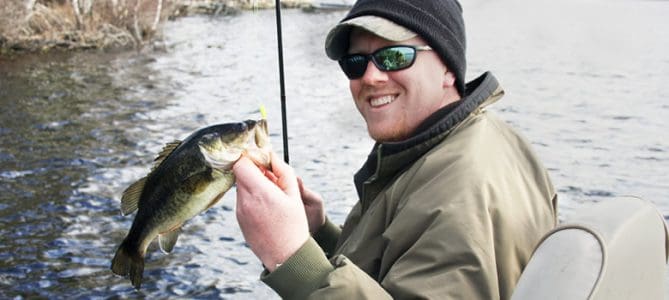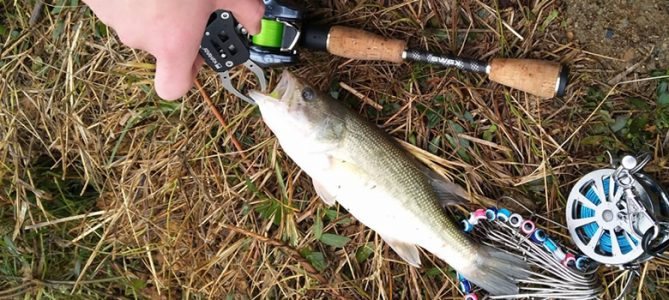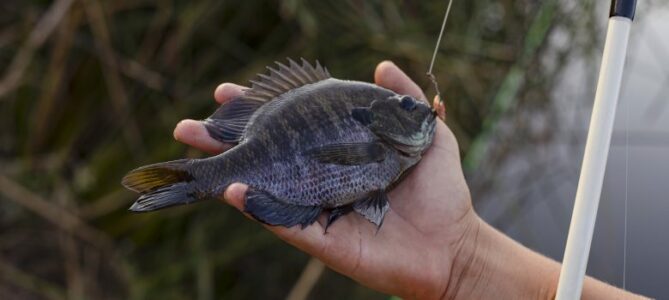If you buy via a link on this page, we may receive a commission, at no extra cost to you.Learn more
Have you ever thought about keeping bass in an aquarium? Many people think only exotic fish can survive in an in-home aquarium, but it is possible to keep bass in one as well.
So, how to keep bass in an aquarium? In order to keep bass in your aquarium, you will have to set up the aquarium specifically for this type of fish. There are size and habitat requirements that cannot be ignored, along with important maintenance and diet issues you must follow to keep your fish healthy.
If you’re looking to get a bass for your home aquarium, but are feeling a little overwhelmed by all the information out there, don’t worry. We’ve got everything you will need to know about how to keep a bass healthy and happy in your home.
First Things First: Is it Legal to Keep Gamefish in a Tank?
The short answer is yes! You can keep gamefish in your aquarium tank as long as you buy it from a licensed dealer.
You will need to check with your state and local laws on whether it is legal to remove a fish from public waters with the intention of keeping them in a tank or releasing them elsewhere. Many areas have regulations against this as introducing bass to a new environment can wreak havoc on the new ecosystem.
No products found.
Items You’ll Need to Set Up Your Bass in Your Home
Before bringing your fish home, you need to do the proper research to ensure you will have the correct resources to care for your fish to the best of your ability. Having the following items will help to make the transition as seamless as possible:
- A large aquarium tank: You can easily pick up an aquarium tank from most pet supply stores. Just make sure you get one large enough for the size of bass you intend on purchasing or catching.
- Chiller: A chiller is a temperature-regulating system for an aquarium. Having regulated temperatures is key for fish to survive in an aquarium.
- Thermometer: Going along with the above, you’ll want to easily read the temperature of the tank at any given time.
- Habitat Items: You’ll want to mimic the natural habitat of a bass. Purchasing things like gravel, rock, algae, and driftwood will help the bass, and any other fish you decide to purchase or catch, feel more at home.
- Food: Stock up on a mix of fresh, frozen, and pellet food. Fresh can get expensive, especially because Bass eat so much at a time every single day.
Next, we’ll get into the proper way to set up your aquarium and resources. There are certain regulations you’ll need to follow to ensure your Bass fish are comfortable and thriving in their new environment.
- Stylish Fluval Aquarium: Contemporary design with...
- Customizable LED Aquarium Lights: Fully adjustable...
- Powerful Fluval Fish Tank Filtration: 3-stage...
Setting Up Your Aquarium
In order to set your aquarium up for native fish, like bass, as opposed to the usual exotic fish, you first must choose the accurate size tank. Choosing the correct tank size will limit the stress from a poor living environment for your fish. It will also give the fish proper and adequate room to swim about.
The tank needs to be large enough to accommodate your bass fish comfortably. Choosing a tank that is 100-150 US gallons will benefit your fish tremendously. Keep in mind, it isn’t just the fish going in here, but also add-ins like plants and other structures.
If your bass grows larger than expected, you may need to transfer them to a larger tank, so they are comfortable and healthy, especially if you want multiple basses in one tank.
You should always consider the space they need to move freely and seek shelter. This will cut down on the stress your bass can potentially experience from less-than-ideal living conditions.
Amount of Fish and Their Habitat Needs
You should only start with two to three fish, at the most, to see how large each of the fish grows, and how much room they’ll have before adding any other fish to the mix. Always remember to transfer your fish to a larger tank if space starts to be limited.
You want to mimic the natural habitat as much as you possibly can. Bass enjoys the lakes, ponds, and rivers they typically call home. Think about what these bodies of water have in them. They are full of rocks, driftwood, and weeds they enjoy in their home. This provides the bass with areas to swim and seek shelter if they need it.
If you visit your local pet store you’ll find plenty of structures, plants, and different types of gravel you can add to your aquarium to make your fish feel more at home.
The Temperature of the Tank
Another important feature to consider is the temperature of your tank. Bass enjoys a climate of 60 to 65 degrees Fahrenheit, and this should keep your fish happy and healthy.
You should consider using a chiller to regulate temperature. You can also place a thermometer in the tank and check it daily to make sure the temperature is staying exactly where it should be. It is very important that your tank stays in the proper range of temperature.
The temperature can certainly waver but should stay consistent between 60 and 65 degrees Fahrenheit for your bass to be comfortable.
Lighting the Tank
If you think about the natural habitat of a bass, note that the lighting plays a major role. Most bodies of water like ponds, rivers, and lakes have a good source of light for about ten hours each day. Utilize proper lighting in your aquarium and set timers to keep lighting on track.
Cleaning the Tank
One thing is for sure about bass, they produce large amounts of waste. The more a fish takes in, the more it will put out. This means you will frequently need to check the filter and clean it out to give it a refresh. The fewer fish you have, the longer you can go between cleanings.
Also, remember that the water will need to be changed every two weeks at a minimum. When changing out the water, make sure the temperature is similar to what is already in the tank, so your bass doesn’t the shock of a sudden temperature change.
Temperature and water quality are both especially important for the health of your bass.
Choosing Your Bass
When it’s time to choose where you’ll get your bass from, you can decide to catch your own from their natural habitat or purchase one in-store.
The benefits of catching your own are the low cost, however, it may be a bit more time-consuming.
If you purchase a bass in a store, the benefit would be that the fish is used to living in a more confined space. You’ll have to call around to smaller pet stores, because many may not carry different types of bass.
Specialty pet stores almost always do, so you can count on them if you can’t find bass at smaller stores. Depending on the store, various types of bass fish range in price from $1.00 to 7.00 per fish.
The choice is yours. Just weigh the pros and cons of each and make your choice using the resources you have.
Different Types of Bass Fish
- Largemouth Bass: distinguished by the upper jaw extending past its eye
- Smallmouth Bass: Brown, Green, or Bronze in color and dark vertical stripes
- Spotted (Kentucky) Bass: has a band along its flank, like the largemouth, but the jaw does not extend past the eye
- Rock Bass: rows of dark spots on their sides and often live near sunfish
- Striped Bass: has a stripe running the entire length of its body.
- White Bass: football-shaped with faint lines across its body
These six are the most common types of bass but there are others, too!
Acclimating Your Bass to the Tank
When bringing your fish home, be sure to start by placing a generous amount of the aquarium water into the bag or bucket your bass are currently in. Gradually continue acclimating your fish over the next hour or so prior to putting your fish in the tank.
Doing this will prevent your fish from going into shock when transferring into the new body of water. Shock occurs when fish experience sudden drops or sudden raises in temperature, or when PH levels change drastically as well.
If you’ve purchased your fish from the store, this may be an easier process due to the fish being used in a smaller environment.
If you’ve caught the fish in the wild, it may take a bit longer due to the fish being used to living in a large lake or pond, or even potentially a river.
Be sure to introduce your fish one at a time when transferring to an aquarium. Depending on how the fish was kept in the store, it may not be used by other fish in their space.
Fish found in the wild is certainly used to other fish being in their home. However, moving these fish to a smaller environment may cause them to be territorial, so introducing them to other fish slowly will help overall.
If fish become overly territorial and continue to fight, there are ways you can try and manage this as well. There are resources online to check out if need be. You may need to ultimately separate them as well, depending on the situation.
What to Feed Your Bass
Think of the types of food that bass eat in their natural habitat. You should try and mimic their foods as much as possible upon bringing them home as well.
Bass enjoys a variety of foods such as:
- Earthworms
- Shrimp
- Algae
You can save money each week by choosing to switch between fresh, pellet, and frozen foods to feed your fish. Fresh food can become very expensive over time and your bass will acclimate to the different variety.
If you choose, you can stock up your aquarium with small prey and minnows. If you stock up on both male and female prey fish and minnows, you will have a naturally reproducing food source for your bass.
Should You Keep Both Male and Female Bass in One Tank?
You should choose to only have male bass, or female bass, in order to prevent overpopulation. If you purchase your bass in a store, the clerk will be able to tell you if you are choosing male or female fish. It can be a bit difficult to determine the difference between the two sexes on your own.
If you are catching your own bass, you can potentially distinguish between males and females by their size as females are notoriously larger than males.
If you aren’t sure and cannot distinguish between male and female bass, a professional should be able to help. You can take your fish to a hatchery and speak to someone who specializes in these issues. It is extremely difficult and near impossible to tell if a bass is male or female without dissection.
These Fish Will Not Cohabitate with Your Bass
Bass eat a variety of other fish. Since Bass are natural-born predators, they tend to try and swallow any fish that are smaller that happen to swim past them. Here is a list of fish to absolutely not put in the tank with your new bass. Keep in mind, this is not every single fish that does not mix with Bass, so do plenty of research prior to adding any fish into the environment.
- Bluegill
- Crappie
- Minnows
- Perch
- Sunfish
They will also eat crayfish and frogs as well, so it would not be wise to have any of these types of fish and other wildlife in the aquarium tank with your bass.
Can You Keep Bass in a Koi Pond?
Adding bass fish to a koi pond that already has koi inside of it has been done before. However, this is a bit of a betting game.
Bass can have bacteria and other parasites, which, when dropped into your koi pond, can wreak havoc on your koi, causing sickness and death.
Since bass is natural predators, they will try and eat smaller species. If your koi fish are larger than the bass, it’s expected that they will be okay to cohabitate. If they are smaller, it’s once again a guessing game.
It has been reported that bass can destroy an entire koi pond rather easily if that’s what they choose to do. If you make sure the koi pond is large enough and has plenty of structures and shelter mechanisms, this will give all of the fish a better chance at survival.
It is important to note that while koi can survive in poor-quality water, bass cannot.
Bass need well-oxygenated water to survive. You’ll need to make sure your pond has this well-oxygenated water. It is relatively simple to do this, just add in a wetlands area and a designated pump. This should provide the oxygen that is needed.
Ethical Issues to Remember
It is perfectly ethical to keep bass in your home aquarium if your tank is large enough to accommodate their growing size.
Remember that if a fish outgrows a tank, you either need to buy a larger tank or rehome them to someone who can properly accommodate the space that they need to thrive.
It would not be a smart idea to release the fish back into its wild habitat for numerous reasons.
It is actually against the law to release them back out once they have been in captivity. It is also unethical. After making the initial decision to bring bass into your home, that fish is your responsibility.
Releasing the bass back into their natural habitat increases the chances of spreading different exotic diseases into the ecosystem, which would completely devastate the population.
A Final Conclusion
It is extremely possible to keep bass in an aquarium; if it is large enough to properly accommodate your fish. Keeping fish in an aquarium is completely ethical as long as the tank is big enough, you are feeding the fish a proper amount of food, and taking care of the fish and its environment.
Purchasing the correct supplies and doing the proper research prior to bringing your fish home are key for the success and health of the fish overall. Be sure to have a large enough aquarium tank, a chiller and thermometer, and the proper food for your fish. Make sure to not skimp out on a good amount of food; bass is big eaters.
Always keep in mind that once that fish is out of its natural habitat, the fish is your responsibility for the remainder of its life. Releasing it back into the wild is harmful not only to the fish but also to the ecosystem that we all enjoy and want to protect.





When I first acquired the bass I have in my tank, its name currently is Willy, assuming it’s a male. He was about 3 inches when I brought him home. Now at this writing, he is 8 inches in length. I like to fish and since I have had Willy in an aquarium, it has given me a new respect for wildlife and fishing. This article gave me more confidence that I am headed in the right direction in taking care of Willy the Bass. I try and get wild-caught minnows for him to feed on from a local stream. But during the colder weather, only large minnows seem to be available. Too big for him to eat. During warmer months smaller minnows and other insects like grasshoppers will be available to throw into the tank. I have found that Willy the Bass is a creature of habit. He comes to the top of the tank when I approach, he’s looking for food, and while observing him, he just looks right back.